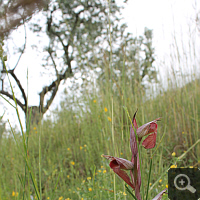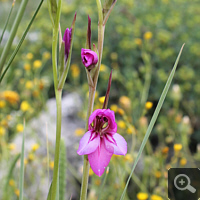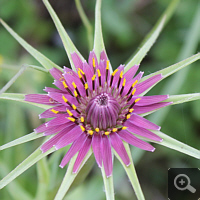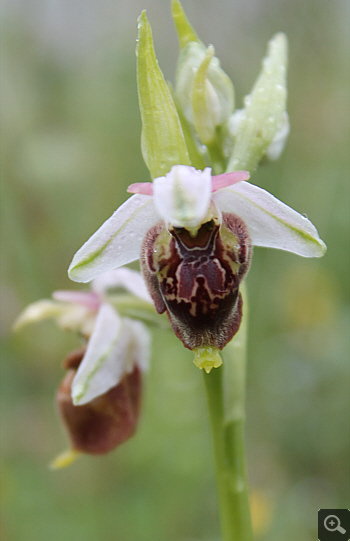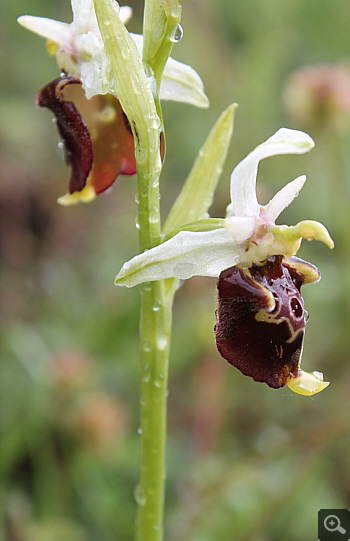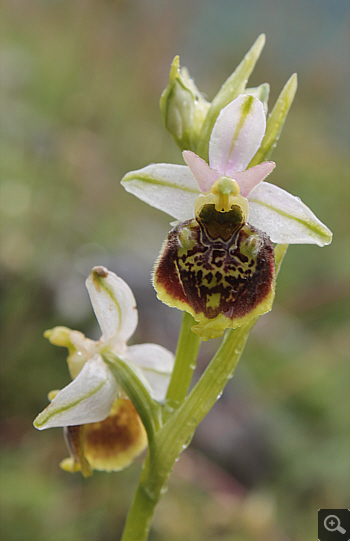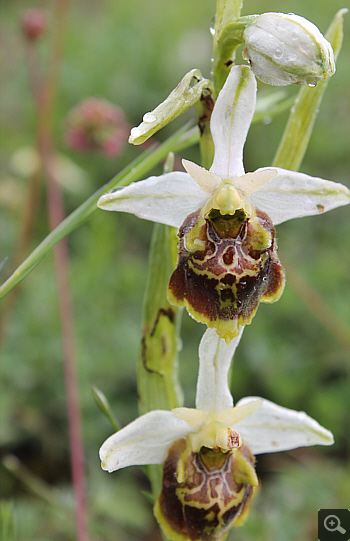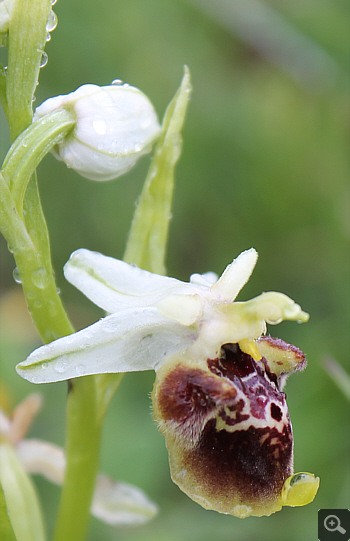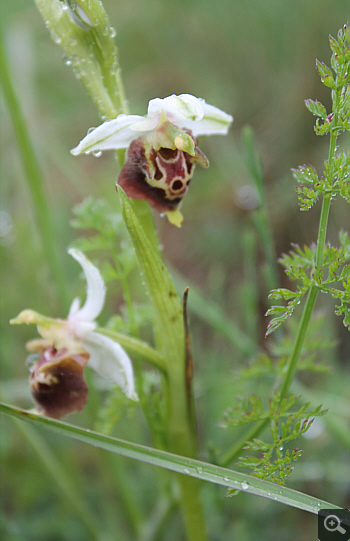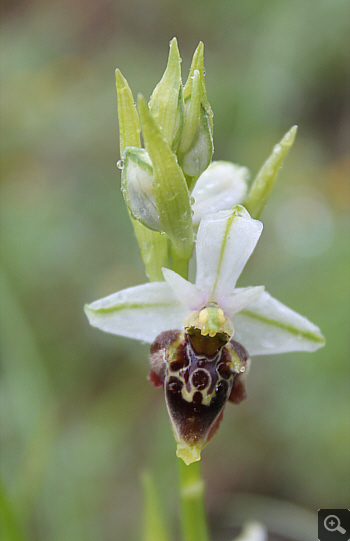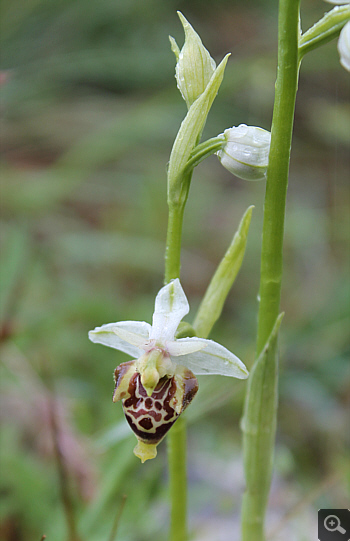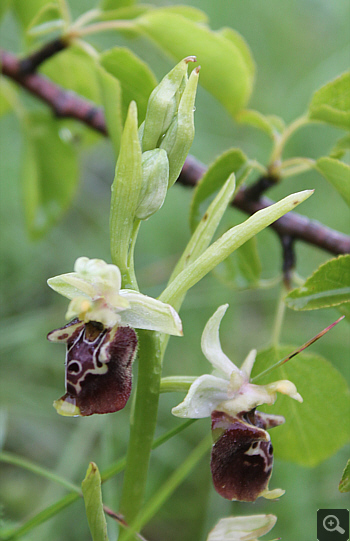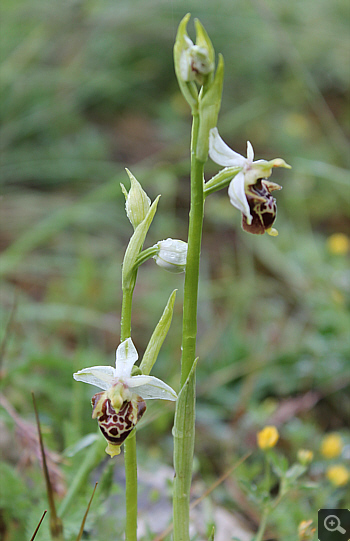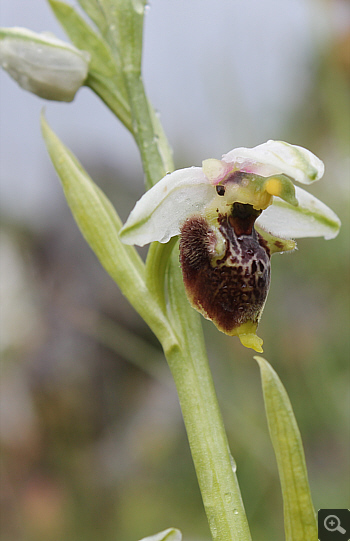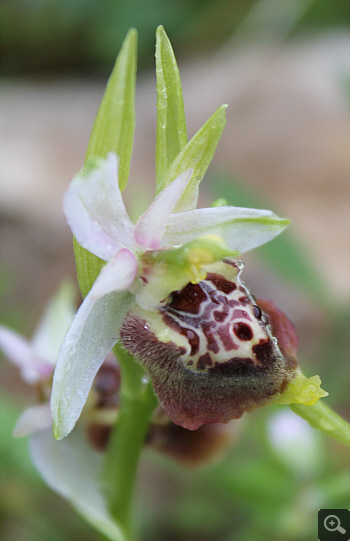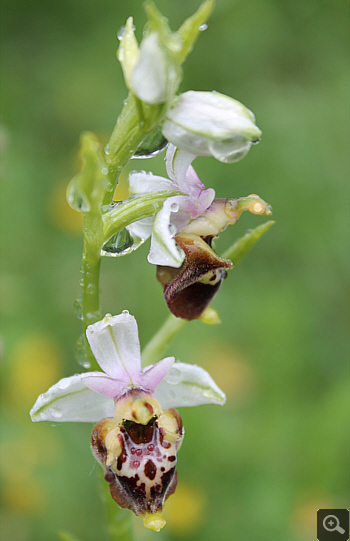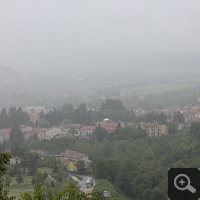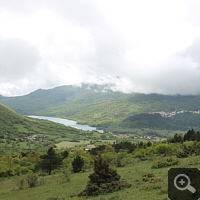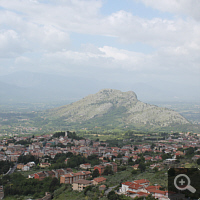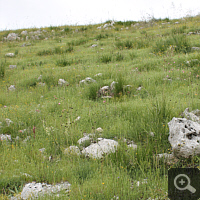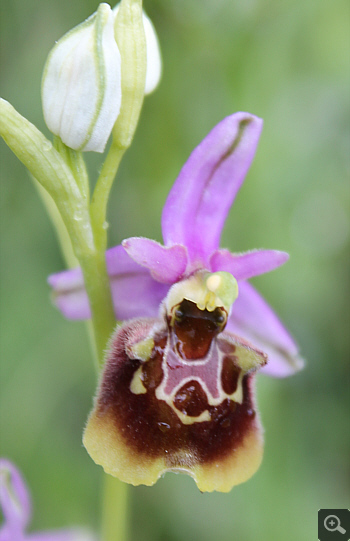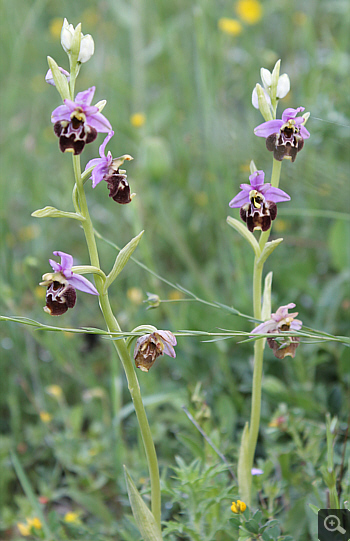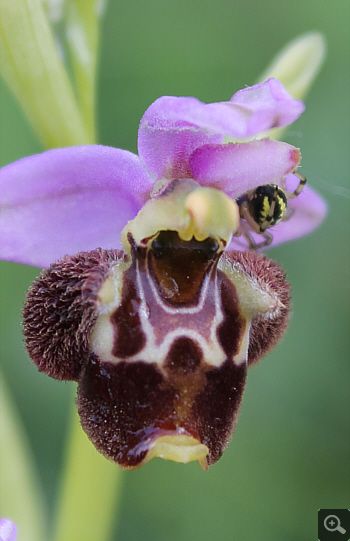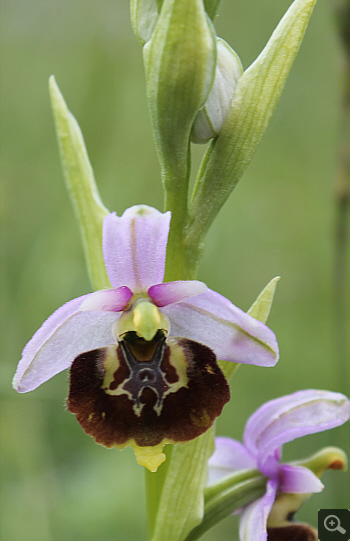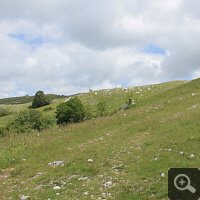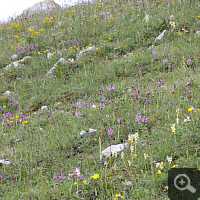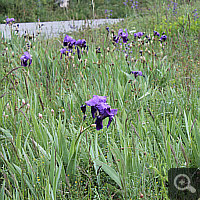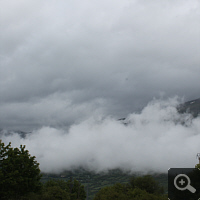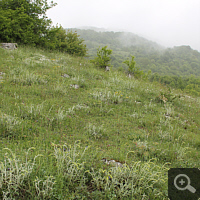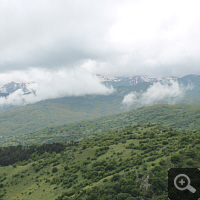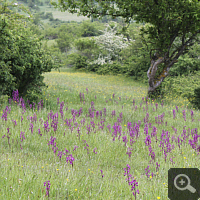
Abruzzi 2013
Overview
Since years I wanted to visit the Abruzzi and photograph Ophrys lacaitae, from which I had already collected some location data. But always intervened something. This year the time has come. Short-term I set out to quick trip in the Abruzzi.
Unfortunately I reckoned without the weather gods, who thwarted my plans properly. In the end of May, I was not really prepared for three days constant rain in what felt like 10 °C in Italy.
The result at the end is: 35 species, 2 hypochromic species, 2 hybrids and hundreds photos of soaking wetn orchid blossoms.
Arrival (21.05.2013)
In Germany I start in sunshine and hit the 1.100 km long road in the Abruzzi. In the district Rosenheim I have a little break and visit an interesting fen. I am still fairly soon, one month later I will photograph here Orchis palustris. Now, in the end of May, I content myself with some photos of Orchis morio.
After crossing of the Brenner Pass weather worsens increasingly. The farther south I drive, the cloudier and cooler it becomes. Near Ancona it starts raining as well. In constant rain I arrive finally in the dark the Abruzzi, where I quickly search a hotel. I hope tomorrow awaits me a better weather.
Searched and found: Ophrys lacaitae. Under way around Rionero Sannitico (22.05.2013)
My quick prayers were not really answered. Overnight it pelted with rain. The next morning lour once more black clouds above the Abruzzi, but still it does not rain. At first, I drive to Rionero Sannitico. From there I have several location data for Ophrys lacaitae.
At first, I stop at an edge of a wood, here are to be found some soaking wet Orchis-species. At the same road I search some kilometres further the first reputed Ophrys lacaitae – location. Unfortunately this species is despite an one-hour search not to be found here. Instead I find Anacamptis pyramidalis, Ophrys bertolonii, Ophrys fusca, Ophrys majellensis, Serapias bergonii and Serapias lingua. Some hundreds metres further I spot at the roadside Ophrys insectifera. This species is in the Abruzzi very seldom to be found.
So it goes on to the second location. But also here is far and wide no Ophrys lacaitae to find. Instead I note additionally on my list Ophrys apulica and Serapias parviflora. Therefore to location number three. After I have found the first Himantoglossum adriaticum and one singleton of Limodorum abortivum, I spot in a forest next to a withered also one blossoming specimen of the sought-after Ophrys lacaitae. Lucky you! At least I am now sure, that I am away during blooming period in the Abruzzi. And on my list are still some locations, so that I am confident, as well some more photogenic specimens to find.
Now it goes ahead to a Serapias – meadow. Here are to be found in addition to the already found species Serapias apulica and Serapias vomeracea. As I am on the opposite meadow some Ophrys apifera and Orchis fragrans photographing, stops at the roadside a motorhome. With the couple from Hesse I get quickly into conversation and we exchange some locations. Later will turn out, that with the exception of one these were contained in my documents anyway. However, because of the conversation I was assured to look around especially thoroughly at these places. At this point once more my heartfelt thanks!
Already the next location is only a few hundreds metres away. Here shall blossom much more than hundred Ophrys lacaitae. Well, hurry up. And actually it is a real eldorado. I find in addition to the promised Lacaitae Ophrys gracilis and probably several hybrids between these both species. Shortly afterwards it starts severely to thunder, so that I revert to the hotel.
Locks of the weather gods remain open (23.05.2013)
Today commences as yesterday has ceased. It is raining in torrents. But a thing like that can not discourage an orchid enthusiast like me. I drive to Alfedena. Here shall exist an interesting diversity of Ophrys from the ‚Holoserica‘- spectrum. After a curve with Iris x germanica I make also quickly a find. In addition to some Serapias I find Aceras anthropophorum, Himantoglossum adriaticum, Orchis pauciflora, Orchis tridentata, Orchis ustulata and the already announced confusing wealth of forms of the ‚Holosericas‘. Many are most likely in conformity with Ophrys apulica. But among them are also specimens with pure white sepals and partly a yellow margin of the labium. About whose assignment I am not clear and for each opinion deeply grateful (You find my email address here).
Here a little selection (Alfedena + Scontrone):
Drive proceeds north. Near Villette Barrea exist also interesting meadows. Primarily are plenty Orchis tridentata and Orchis ustulata present. These stands partly directly next to each other, nevertheless I do not find a hybrid between both species. As additional species join Orchis morio, Aceras anthropophorum, Listera ovata and Neottia nidus-avis. Furthermore I find at the edge of the forest Cephalanthera damasonium and Cephalanthera longifolia.
After a cappuccino-break in the lovely village Civitella Alfedena rain has decreased something, so that I drive back to Scontrone. According to the statement of the Hessian couple shall exist here diverse ‚Holosericas‘ too. And actually is the wealth of forms perplexing. You find some photos in the above photobox.
On the continuation of the journey to the second tip rainfall regains weight distinctly. The windscreen wiper is in continuous service. Finally I reach the meadows near Montenero. Here it has mass existence of Orchis laxiflora. Under thousands normally coloured specimens the circa one dozen hypochromic specimens are known already from distance. This day is after all enough to drive you up the wall: I drive from one gorgeous meadow to the next and above one is an endless coming and going of thunderstorms.
After some hours at 10 °C and constant rain I am soaked to the skin and not only mentally snuffy. Enervated I terminate the today’s orchid search.
Propitiative end with one hybrid (24.05.2013)
Today is the last day in the Abruzzi. Tomorrow morning I have to meet my daughter at the station in Rom. At night the last thunderstorm has left the Abruzzi. Admittedly it does not rain anymore, but in return it will become today quite windy. Also no optimal conditions for photographing.
But firstly is due a short drive in the region Latium. Here is my first aim the Lago Selva. In the soaking wet meadow at the embankment I make a find quickly and photograph Coeloglossum viride, one blossoming Dactylorhiza saccifera and Platanthera bifolia. Next it goes to Cervaro. At the roadside appear repeatedly Ophrys apifera, Orchis italica, Orchis mascula ssp. signifera and Orchis purpurea.
From Cervaro goes it via the Forcella di Cervaro to Acquafondata. It has along this route several interesting meadows. Shortly behind Cervaro shall be located a further Lacaitae-biotope. In addition to Ophrys gracilis I find then also some specimens of Ophrys lacaitae. And once more a handful Ophrys, whose assignment is hard for me.
But see for yourself:
Eastwards extend long-drawn karst hills. These are admittedly very poor in individuals, but but on the other hand rich in species. In addition to many already known species I find on these hillsides Orchis papilionacea and Platanthera chlorantha.
The Forcella di Cervaro is extreme rich in individuals and species. First and foremost pots of Orchis morio and Orchis pauciflora grow here. Furthermore I find two Orchis simia and many Coeloglossum viride. At an altitude of 1.053 metres is vegetation not as far progressed as further below, so that I find as well some photogenic specimens of Ophrys promontorii.
Finally I reach Acquafondata. Here shall exist the hybrid Orchis tridentata x ustulata, which I even find after a short search. Two very nice specimens amidst of the parents.
Now it is already afternoons and time has come for me to start for Rom. Just in this moment sky breaks through and the Abruzzi say goodbye to me with bright sun.
Itinerary
| date | weekday | visited locations |
|---|---|---|
| 21.05.2013 | Tuesday | arrival |
| 22.05.2013 | Wednesday | Rionero Sannitico, Vandra |
| 23.05.2013 | Thursday | Alfedena – Barrea, north of Villetta Barrea, Montenero, Scontrone |
| 24.05.2013 | Friday | Lago Selva, östl. Cervaro, Forcella di Cervaro, Acquafondata, departure |
Found species
| no. | genus | species | notice |
|---|---|---|---|
| 1. | Aceras | antropophorum | |
| 2. | Anacamptis | pyramidalis | |
| 3. | Cephalanthera | damasonium | |
| 4. | longifolia | ||
| 5. | Coeloglossum | viride | |
| 6. | Dactylorhiza | saccifera | |
| 7. | Gymnadenia | conopsea ssp. conopsea | |
| 8. | Himantoglossum | adriaticum | |
| 9. | Limodorum | abortivum | |
| 10. | Listera | ovata | |
| 11. | Ophrys | apifera | |
| 12. | apulica | ||
| 13. | fusca | ||
| 14. | gracilis | ||
| 15. | insectifera | ||
| 16. | lacaitae | ||
| 17. | lacaitae x gracilis | hybrid | |
| 18. | majellensis | ||
| 19. | promontorii | ||
| 21. | Orchis | italica | |
| 21. | laxiflora | ||
| 22. | laxiflora | hypochrome | |
| 23. | mascula ssp. signifera | ||
| 24. | morio | ||
| 25. | papilionacea | ||
| 26. | pauciflora | ||
| 27. | purpurea | ||
| 28. | simia | ||
| 29. | tridentata | ||
| 30. | tridentata | hypochrome | |
| 31. | tridentata x ustulata | ||
| 32. | ustulata | ||
| 33. | Platanthera | bifolia | |
| 34. | chlorantha | ||
| 35. | Serapias | apulica | |
| 36. | bergonii | ||
| 37. | lingua | ||
| 38. | parviflora | ||
| 39. | vomeracea |

